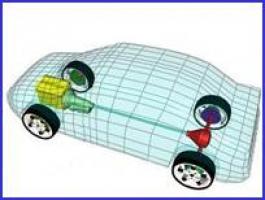Vehicle Systems Modeling and Optimization
 Optimizing the vehicle system is essential for achieving higher fuel efficiency. My research addresses the need to better understand energy demand from a vehicle subsystem standpoint and tackles the challenge of optimal hardware and control system design.
Optimizing the vehicle system is essential for achieving higher fuel efficiency. My research addresses the need to better understand energy demand from a vehicle subsystem standpoint and tackles the challenge of optimal hardware and control system design.
I apply hybrid semi-empirical and analytical approaches that combine first principles with detailed component speed and load data and a Matlab®/Simulink® Energy Analysis Tool to analyze the vehicle energy supply and demand over specified drive cycles. This energy analysis methodology can account for the instantaneous and accumulated vehicle subsystem energy usage and reveal prevailing fuel economy factors for city and highway driving. This research was used by Oak Ridge National Laboratory to populate the Environmental Protection Agency’s (EPA) fueleconomy.gov website.

I developed a reverse dynamic optimization methodology for optimal powertrain integration and control design. A reverse tractive road load demand model developed in Matlab®/Simulink® propagates the required wheel torque and speed derived from vehicle speed and road grade through the powertrain system to determine the required fuel flow for all possible states within the hardware constraints. The control strategy is treated as a multi-stage, multi-dimension decision process, where dynamic programming is applied to find an optimal control policy that minimizes the accumulated fuel flow over a drive cycle. This research resulted in U.S. Patent #8,050,856, “Methods and Systems for Powertrain Optimization and Improved Fuel Economy.” Using this methodology, I developed a Powertrain Matching Analysis Tool, which is currently used by an Automotive OEM to optimize future vehicle programs.

My current research involves developing vehicle system models and algorithms for prediction and optimizing powertrain configurations and control strategies for advanced vehicular technology, such as continuously variable transmissions and hybrid electric vehicles.
Related Publications
Baglione, M., Duty, M., “Development of a Powertrain Matching Analysis Tool,” SAE Technical Paper 2010-01-0490, Presented at 2010 SAE World Congress, April 13-15, 2010, Detroit, MI.
Baglione, M., Duty, M., “Reverse Dynamic Optimization of Variable Displacement Engine Operation and System Integration.” Proceedings of the 2008 ASME Dynamic Systems and Control Conference, October 20-22, 2008, Ann Arbor, MI.
Baglione, M., Duty, M., “Development of Reverse Dynamic Optimization Methodology for Optimal Powertrain Integration and Control Design,” Proceedings of the ASME 2008 International Design Engineering Technical Conferences & Computers and Information in Engineering Conference, August 3-6, 2008, Brooklyn, NY.
Baglione, M., Duty, M., Pannone, G. “Vehicle System Energy Analysis Methodology and Tool for Determining Vehicle Subsystem Energy Supply and Demand,” SAE Transactions Journal of Passenger Cars: Electronic and Electrical Systems, Vol. 116, No. 7, 2008.
Baglione, M., Duty, M., Ni, J., Assanis, D., “Reverse Dynamic Optimization Methodology for Maximizing Powertrain System Efficiency,” Proceedings of the 5th IFAC Symposium on Advances in Automotive Control, August 20-22, Monterrey, CA, Vol. 5, No. 1, 2007. Invited as plenary presentation.

